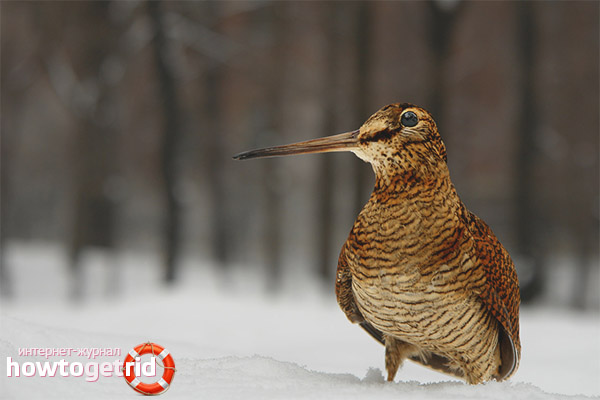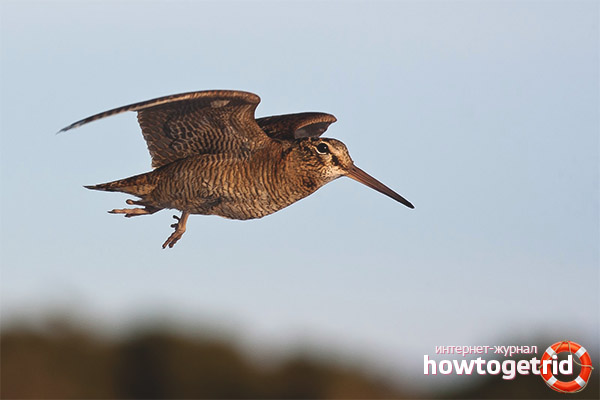The content of the article
Woodcocks are often called forest waders, they differ from other birds by a long beak, black-brown feathers and a stocky body. Of all the species of this bird, two are distributed almost everywhere, the rest are found only on some islands. Woodcocks have a simple daily routine - they hide or fly all day, fly for food when the sun hides behind the horizon. It is not very easy to notice this bird because of their dark peculiar plumage.
Description
The main features of the bird are its large body and long beak. The length of the body is 30-40 cm, the wingspan is 50-65 cm, it weighs differently - from 200 to 500 grams. The color of the feathers is mainly brown or dark brown, sometimes individuals with black, gray or bronze feathers are found. The abdomen is light with a cream or dark yellow hue, with black stripes. This special coloring helps the bird to easily hide among the fallen autumn foliage. The beak is 9 cm long. The eyes are almost at the top of the head and give a good overview around you. There is a thin black strip on the heads near the beak, and several more stripes can be seen on the head and neck of the bird.
The flight of the woodcock is very similar to the owl, and their wings themselves are wide, but short due to the small size of the body. There are no sexual features, only young representatives have a slightly different wing color.
Lifestyle
Food
The main diet consists of earthworms, beetles, larvae, spiders and other insects. The main condition for choosing a habitat is the presence of fertile land with living creatures living in it. In addition to insects, they can eat grass seeds, grains, berries. During migration, they feed on different mollusks, crayfish and their relatives. For food, birds fly off in the evening or closer to night. Typically, their land is located near their place of residence - in meadows or marshes near the forest. The process of catching food under the ground is quite interesting - the bird inserts its beak into the ground and, thanks to its sensitivity, senses the slightest vibrations of the earth, which makes it easier for itself to search for food.
Habitat
The main residence of the woodcocks is the forests and steppes of Eurasia, they can be found everywhere, from the Misty Albion in the west, and in the coastal territories of the far east. In addition, some species of birds live only on islands in different regions of the planet. Many birds have a migratory lifestyle, they spend the winter in southern Europe, in northern Africa, in the Near and Middle East, in India, China and Southeast Asia. Settlers are only representatives of the islands and maritime countries of Western Europe.
Autumn migrations begin with the first frosts and last from October to November, while they can fly to completely random places, even where they were not before.Spring flights begin in February, and by the end of May they return to their nests, many to the place of birth.
Nests are made in dense forests with soft soil and with overgrown berry bushes, hazel and ferns. Near potential nests there must necessarily be a body of water, preferably a swamp with forest edges. There they seek food and rest.
Types of woodcock
- Auckland Woodcock. The main habitat is New Zealand and nearby islands, the body size of representatives of this species is smaller than that of the rest, they do not differ in color of feathers.
- American woodcock. Found on the east coast of North America. This species is slightly smaller than its counterparts, it has significantly smaller legs, the body and head are more round in shape, the beak is equally long and straight. Also, their weight is much less than that of conventional woodcocks, and females are usually larger than males. Feathers are often quite mottled in color - brown, black, brown and gray. On the sides, the color fades from white to bronze. There are several black or brown stripes on the head and back of the head. The view has very short small legs.
- Amani woodcock. A very rare species, found only on two islands near Japan. The main differences from the rest are narrow wings and a dark strip on the tail, as well as white plumage near the eyes (in other species this place has a different color).
Differences between females and males
Woodcocks have only one sexual difference - size, depending on the type of female, can be larger than males.
Woodcock Conversations
Woodcocks rarely make sounds, except for the mating season - at this time in flight males make sounds remotely similar to grunts. And they finish their singing with high notes. You can hear them at a distance of 400 meters. The male chases rivals in the female with squealing sounds.
Woodcock propagation
Woodcock pairs are created only at the time of pairing. After the passage of all frosts, the token period, special for many birds, begins. In woodcocks it is mating flights of males over their females. Males become especially energetic after sunset and before sunrise. At this time, they slowly fly with their heads bowed and make their characteristic sounds, which at the end of the flight turn into whistling and popping.
Woodcocking continues from late spring to summer. Females are waiting for their males on the ground, in dug nests. If two or more birds meet in flight, a fight may ensue. When a female from the earth makes her sound, the male flies up to her and a mating pair of birds is created for a short time. After mating, the male forever leaves his partner and never returns. For one season, each woodcock male, on average, finds 3-4 females.
Females make nests of these birds; for this, they look for empty areas of the forest where they dig holes or holes in the ground, sprinkling with branches, leaves, moss and grass. The depth of such a nest is 15 cm, and the thickness of the leafy litter is 20-30 mm. Here the female lays up to 4 eggs. The color of the egg may be reddish-brown with gray or dark dots. If the bird has lost its clutch, it makes a new one. Eggs hatch for about 24 days, while the female can leave her nest only in case of near danger.
Chicks are born in fluff, with pale and large spots. After 10 days, as the chick hatched, the first feathers appeared, and after 3 weeks he began to learn to fly. If a predator comes too close to the nest, the female makes a screaming sound and takes the chicks to a new place.
Hunting
On the territory of Russia and neighboring countries, woodcock is hunted mainly in the spring, when they just fly to the nests and are quite easy to find. There is even a separate hunting scheme at this time - “mud hunting”.In spring, woodcocks become easy prey even for the most inept hunter, but in autumn only the best hunters, with a faithful gun, a trained hound and knowing all the tiniest details of such a hunt, can hunt this bird. Hunting for these birds begins with the opening of a common hunting season for all forest game.
In the western and southern countries of Europe, where woodcocks fly away in winter, local hunters hunt them for almost the entire winter.
Interesting Facts
- The eyes of the bird are arranged so that they can see 360 degrees.
- The name "woodcock" itself comes from the German expression, which means "forest sandpiper".
- Mentioned in many literary works, including Dahl, Turgenev. In some works of these birds are called - "kings of the game."
- If a predator approaches the nest, a woodcock can pretend to be wounded and try to lead the enemy away from the nesting place or chicks.
Video: Woodcock (Scolopax rusticola)












Submit